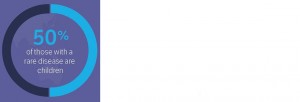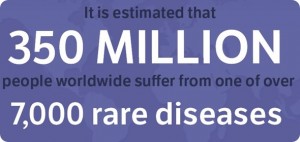 A list published by the US National Institutes of Health show that so far the world has found nearly 7,000 kinds of rare diseases, including many unheard strange disease.What are the current main challenges in the diagnosis of a rare disease and how long does it typically take? Nicole Boice (NB): The main challenges in the diagnosis of rare disease are apparent, there are 7,000 identified rare diseases with hundreds of new diseases being discovered annually. It still takes an average of 7.2 years to properly diagnose a rare disease because our healthcare providers are not equipped with enough information and expertise to make the proper diagnosis right away.
A list published by the US National Institutes of Health show that so far the world has found nearly 7,000 kinds of rare diseases, including many unheard strange disease.What are the current main challenges in the diagnosis of a rare disease and how long does it typically take? Nicole Boice (NB): The main challenges in the diagnosis of rare disease are apparent, there are 7,000 identified rare diseases with hundreds of new diseases being discovered annually. It still takes an average of 7.2 years to properly diagnose a rare disease because our healthcare providers are not equipped with enough information and expertise to make the proper diagnosis right away.
Right now, the healthcare system is still designed to start diagnosis via a general practitioner rather than a specialist. There is a new form of thinking and schooling in development that suggests the first line of defense and diagnosis should be a geneticist, to get to the root of the problem first.
Please can you give an introduction to medical crowdsourcing and the potential impact it could have on the diagnosis and treatment of rare diseases?
Dr Teri Willochell (TW): To me, medical crowdsourcing is like the ultimate consult service. A question arises, it is asked on the forum, and you can get answers from multiple specialties within minutes. It is harnessing the brightest minds in one place and using that power to do what we enjoy doing most – helping people.
NB: The more great minds we have to tackle the problem the better chance we have of finding the solution. Over the last few years crowdsourcing has changed business and fundraising models. In regards to healthcare, it truly is the power of varied expertise coming together to help tackle some of the greatest challenges.
Physician social network SERMO and rare disease patient advocacy organization Global Genes recently announced a partnership. How do you hope this will help doctors to diagnose and treat rare diseases?80% of rare diseases are genetic in origin.
TW: I believe that this collaboration will help put some of the rare diseases into physician’s consciousness when they encounter patients with unusual symptoms. It will also help those physicians taking care of patients with rare diseases not feel so alone. To me, it’s a win-win situation.
NB: We are very excited about the partnership. We have already seen and continue to see the power of this network help patients through programs like our current RARE Concierge Program.
Can you explain how the new program SERMOheroes will work?
Peter Kirk, CEO of SERMO (PK): The SERMOheroes program connects rare disease patients to targeted physicians through SERMO, the leading global social media network for doctors and the home of medical crowdsourcing.
Global Genes initiates the process, as they regularly work with rare disease patients and their families through the Rare Concierge program. If the patient’s doctor is not a SERMO member, the patient is paired with a “SERMOhero”, a physician who volunteers to sponsor (post) their case on the social network.
The SERMOhero works with the patient and their family, Global Genes, and/or the treating physician to collect all relevant information about the case, posts the case in the SERMO community for physicians to consult on and acts as a liaison to gain additional information as requested.
Once a consensus is reached, the SERMOhero provides a brief for the patient and their treating physician.
What impact will this have on patients’ lives?
TW: Patients will have the advantage of the collective knowledge of hundreds of thousands of physicians worldwide to help with their diagnosis and treatment. All in a short period of time, all at no cost to them.
5th Birthday mortality rates
How is the SERMOheroes service being funded and how do you think this will affect the medical costs associated with diagnosing and treating patients with rare diseases?
PK: SERMOheroes is a partnership between SERMO and Global Genes. The service is free to patients and participating physicians (SERMOheroes and the consulting physicians) are not paid for their participation.
Our hope is to alleviate some of the burden of cost for rare disease patients by using medical crowdsourcing to help them get the right diagnoses and treatments faster.
What will be the main challenges and how do you hope to overcome them?
TW: One challenge will be getting the information between SERMO members and the organization. I will be acting as a liaison along with a few others members of the community and the organization. With email and texting, this shouldn’t be as taxing as it would have been even a few years ago.
What do you think the future holds for the diagnosis and treatment of rare diseases and how do you think technology will impact what’s possible?
TW: Hopefully, with newer genetic testing and interventions and better diagnostic techniques, “rare” diseases will become more mainstream; physicians will know more about them and how to better treat them.
What potential does crowdsourcing have for other areas of medicine?
TW: Possible novel treatments for diseases, reporting of drug-drug interactions or adverse reactions, new potential surgical interventions or techniques – the possibilities are endless.



